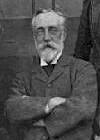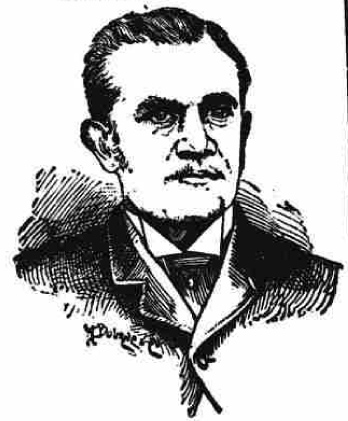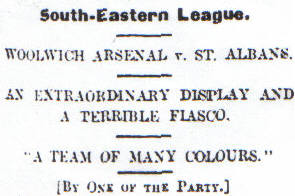This First and Last feature looks at the opening and closing game played by the original St Albans club. The gap between the two games spans 23 years, 1881-1904, a few name changes, the embracing and getting shot of being a professional outfit and, in 1894, being the first club to play at the newly opened Clarence Park .
The first game played by the original St Albans Football Club
 The possibility of forming a football club to represent the people of St Albans had been discussed several times in the years leading up to the club finally coming to fruition in September 1881. The first game took place on 22nd October and was against a club calling itself Hemel Hempstead but is not related to our neighbours paying us a visit this afternoon.
The possibility of forming a football club to represent the people of St Albans had been discussed several times in the years leading up to the club finally coming to fruition in September 1881. The first game took place on 22nd October and was against a club calling itself Hemel Hempstead but is not related to our neighbours paying us a visit this afternoon.
A practice match for the original Saints took place on 24th September at ‘Mr Miskins meadow’ in Wellclose Street in the heart of the city. Further practice matches took place here and at Jacob Reynolds (left) field prior to the first organised game. Jacob Reynolds’ field was off Hatfield Road. It has not been possible to verify the exact location of the ground but, using hints in reports from later years, it would be reasonable to believe that it fell within the area that became Clarence Park . The following is how the Herts Advertiser reported the match.
‘FOOTBALL – The first match of the season of the St. Albans Club was played on Saturday afternoon, in drenching rain, on their ground in Hatfield-road, kindly lent by Mr. J. Reynolds. The local team competed with the Hemel Hempstead Club, and, owing to want of sufficient practice and to most of the members being new to the game, the former were defeated by four goals to nothing. The play of Winter, the visitor’s captain, was specially noticeable. T.L. Brash officiated as captain to the local team. The following were the sides – St. Albans: J.R.Ball, G.Brown, T.Harris, F.J. Preece, A.Webdale, H.C.Webdale (forwards), F.Gentle, Herbert Slade (half backs), L.Sell, T.L.Brash (backs), and R.Cook (goal). Hemel Hempstead: F.St. J.Badcock, Roget, Winter (captain), Puddifoot, Clarke, Woodman (forwards), Burrage, R.H.Balderson (half backs), Hanock, Collins (backs), Bethom (goal). Mr. W.Masters kindly officiated as umpire. The next match will be with Luton Excelsior to-day (Saturday), at 3 o’clock, on the same ground when, in all probability, there will be better play than shown a week ago.’
 Richard Cook (left), who played in goal against Hemel, was appointed hon. secretary to the new St Albans club and a profile of him suggests that his best position was off the pitch; ‘his exertions as a player were more beneficial to his liver than his club.’ Cook passed away on 6th December 1899 at the age of 51. St Albans got through five different goalkeepers in their first six matches with the Hemel custodian J.Bethom being among them.
Richard Cook (left), who played in goal against Hemel, was appointed hon. secretary to the new St Albans club and a profile of him suggests that his best position was off the pitch; ‘his exertions as a player were more beneficial to his liver than his club.’ Cook passed away on 6th December 1899 at the age of 51. St Albans got through five different goalkeepers in their first six matches with the Hemel custodian J.Bethom being among them.
St Albans played 15 games during their first season, all of which were friendlies. Nine were held at Jacob Reynolds field with the Saints failing to score in the first five. The goal that secured the sweet taste of victory for the first time came during a match with Mr James Woods team of Salisbury Hall, Barnet, on 26th November, at Hatfield Road. The honour of scoring the first goal went to F.J.Preece following a pass from R.Faning. The Rev R.E. Faning was the first of several ‘men of the cloth’ to play for St. Albans during the early years.
The Saints kept playing friendly matches for five years until 6th November 1886 when they faced Watford Rovers at the Rose & Crown Meadow, Watford, in the First Round of the newly launched Herts County Football Challenge Cup (better known today as the Herts Senior Cup). Watford Rovers, a forerunner to the present-day Watford club, won 3-0.
The final game played by the original St Albans Football Club
The club, or at least a variation of, which first brought football to St. Albans back on 22nd October, 1881, took to the field for the final time on 30th April, 1904, with a trip to Woolwich Arsenal's Manor Field home in Plumstead. The game was a South Eastern League fixture with the Gunners looking to secure the championship and clinch a few personal records along the way. The original Saints could hardly have been more obliging.

It was lambs to the slaughter as a weakened XI faced the mighty Gunners. The Saints problems began behind the defence and ran right through to the attack. Regular goalkeeper A.Turner was unavailable with his place being taken by Charlie Earwicker. Perhaps aware of the impossible task ahead of them Turner was wise to give the game a miss. His importance to the Saints was clear as his absence from games during the previous three seasons coincided with defeats of 11-1 and 10-0. That said, he was between the sticks in matches which saw the Saints concede eight and nine goals. The trip to Plumstead and the ninety minutes fiasco that followed was far too ridiculous to have been a piece of fiction. The St. Albans-based Hertfordshire Standard gave an almost gruesome account of the far from glorious finale, parts of that report are included here. St Albans been expecting to field a strong side but those plans fell apart in startling fashion, as the newspaper recorded.
‘At 12.40 on Saturday afternoon a small band consisting of Dick Cox, Alf Seabrook, T. Shrewsbury, C.W. Packford, George Hartley (left), W. Atkins, G. Marshall, E. Westell, the linesman, and C. Earwicker, the Tabernacle goalkeeper, assembled on the Midland Railway platform in St Albans - seven players in all.’ The not so magnificent seven went to St Pancras, across the road to Kings Cross and onto Moorgate Street.
‘On the way the players had a great stroke of luck. Three men were still required to complete the team, for Howard was to be met on the ground. Looking round the compartment three young fellows in working garb were seen, and with a happy inspiration, Dick Cox approached them on the subject of football. By judicious pumping it was learnt that these young men could play, and after a little persuasion they were enticed into a promise to play, and so accompanied the Albanians to Woolwich.’
 Further good fortune struck them at Moorgate Street when they bumped into another St Albans player, E..N. Histed, who readily agreed to play. Upon reaching the ground the Saints relied upon the kindness of the home side to provide kit for the three secret weapons picked up en route. Several players wore kit that was the wrong size for them while Histed opted for playing in his socks due to his borrowed boots being far too large for him. Marshall wore blue knickers and a grey Arsenal training shirt, Howard was decked out in a faded pink and green shirt and Packford proudly wore his Oxford City blue and white stripes. The problems mounted after the kick off as Shrewsbury left the pitch within five minutes due to feeling unwell.
Further good fortune struck them at Moorgate Street when they bumped into another St Albans player, E..N. Histed, who readily agreed to play. Upon reaching the ground the Saints relied upon the kindness of the home side to provide kit for the three secret weapons picked up en route. Several players wore kit that was the wrong size for them while Histed opted for playing in his socks due to his borrowed boots being far too large for him. Marshall wore blue knickers and a grey Arsenal training shirt, Howard was decked out in a faded pink and green shirt and Packford proudly wore his Oxford City blue and white stripes. The problems mounted after the kick off as Shrewsbury left the pitch within five minutes due to feeling unwell.
Needless to say, St Albans did not go down with all guns blazing and slithered to an 11-0 defeat. Even so, the Saints avoided finishing bottom of the table on goal average from Chesham Generals. The game was a farce but the 5,000 crowd went home happy as the South Eastern League title weas captured. The leading goal scorer for Woolwich Arsenal Reserves, who also won the London League, was Crowe who notched a remarkable 70 goals and by virtue of knocking in their 200th goal of the season during the final day rout of St Albans, was presented with a gold watch and chain.
St Albans: C.Earwicker, C.W.Packford, W.Atkins, A.Seabrook, A.G.Cox, G.Marshall, E.Howard, E.N.Histed, T.Shrewsbury, plus two unnamed players.
